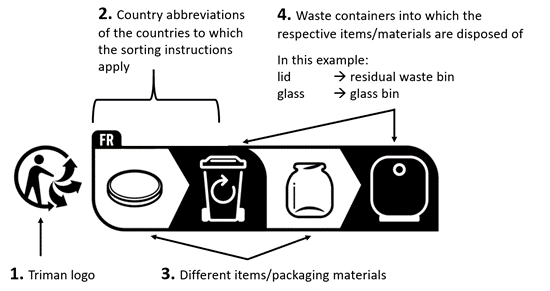RECYCLING
Department of Environmental Management Winora-Staiger GmbH
BASICS
Department of Environmental Management Winora-Staiger GmbH
Product responsibility obligates the manufacturer to proper disposal and environmentally friendly recycling, even when the products reach the end of their service life. This includes proper disposal and environmentally friendly recycling.
Winora Group sells its products worldwide. We take responsibility for the disposal of our goods beyond German borders and offer licensed products in compliance with national environmental regulations in many countries.
The increased manufacturer’s responsibility mainly concerns the return and use of your electronical devices, packaging and/or batteries as well as accumulators.
Electrical appliances
Worldwide, there are numerous statutory stipulations and directives which define the return and disposal of electrical appliances. The internationally best known directive is the European WEEE Directive 2002/96/EC and its amendment 2012/19/EU in Europe. This directive regulates, among other things, the environmentally sound disposal of waste electrical and electronic equipment (WEEE).
Batteries
Many countries worldwide have set country-specific take-back obligations as a requirement for the manufacturers of the products, among others. In addition to the European Battery Directive 2006/66/EC, there are many other laws worldwide that regulate the take-back and recycling of batteries and accumulators.
Packaging
Packaging waste generated after the sale of products in many countries falls under the country-specific take-back obligations as part of extended producer responsibility.
Probably the best known directive in this field is an EU directive. In our case it is the Packaging Waste Directive 94/62/EC, combined with its amendments in 97/129/EC.
Electrical appliances (waste electrical equipment)
According to the WEEE Directive, many Winora Group products are classified as electrical equipment. For instance, the entire eBike, excluding batteries, is considered to be waste electrical equipment. If individual components of the drive unit must be disposed of, these are of course also classified as waste electrical equipment.
In addition, the following general bike components are also affected by the definition:
LED headlights, LED rear lights, bike computers and parts of electronic shifting or damping systems as well as further electrical accessory.
Batteries (li-ion batteries and various battery types)
In general, all types of batteries and accumulators are affected by the directives. The lithium-ion batteries for our ePerformance products make up the largest part of our batteries.
In addition, it includes smaller batteries such as display batteries, batteries in electronic shifting or damping systems as well as disposable batteries in other accessory parts.
Packaging (transportation and sales packaging)
Winora Group ships all vehicles and parts to retail in cardboard packaging. This transport and partly also sales packaging consists of cardboard and plastic.
RECYCLING PROCESS
Department of Environmental Management Winora-Staiger GmbH
NOTE
If one of these symbols is attached to a product or its packaging, it must not be disposed of in normal household waste. In this case, it is e.g. an electrical appliance or the appliance contains batteries. Observe the relevant regulations for the separate disposal of electrical and electronic products and batteries. Proper disposal serves to protect the environment and health. In this way, recycling cycles are most effective.
Entire vehicles
Do not dispose your vehicle in household waste. Dispose it at a local authority collection site or at a recycling centre. Alternatively, there are collections organised by municipalities or private companies. Please contact your responsible municipality or city administration or look out for information in your mail.
Electrical elements, batteries and accumulators
For pedelecs, S-pedelecs, bicycles with electric shifting or damping systems, all batteries or removable components containing batteries must be dismounted in advance. This includes drive unit batteries, displays with fixed batteries, batteries integrated in or on the frame for shifting and damping systems, etc. Removable displays with an integrated battery, displays that still provide an active indication after being removed from the handlebar and do not have an recognisable battery compartment on the rear must be disposed of as a whole. It is only permitted to open a battery case which is accessible from the outside (usually a button cell). The display housing must not be opened to remove a fixed battery. Fixed display batteries are usually lithium-ion batteries and therefore hazardous waste. They must not be disposed of in household waste but must be taken to a local authority collection site or a recycling centre. This also applies to replaced batteries that were removed due to wear or defect. Please also observe the information in the chapter “Safety instructions / Battery safety instructions” in the supplementary Pedelec, S-Pedelec user manual. Standard batteries – so-called portable batteries – can not only be disposed at a local collection site or a recycling centre, but can also be thrown into battery collection boxes, which are set up in various shops. After the battery(ies) have been removed, the remaining part of the vehicle is designated as waste electrical equipment and must be recycled separately. Please refer to your specialist dealer, the local collection site or a recycling centre for any further questions.
Note on the identification of batteries and accumulators
To ensure that batteries or accumulators contained in electrical or electronic equipment can be clearly identified, attention should be paid to the labelling of the equipment and also to the description in the enclosed user manuals. By identifying the type and the substances and materials used, conclusions can be drawn about the proper handling and disposal.
If batteries or accumulators contain mercury (Hg), cadmium (Cd) or lead (Pb), you will find the respective chemical symbol below the symbol of the crossed-out dustbin.
Electronic components and accessory
LED headlights, LED rear lights or hub dynamos, as well as accessory parts such as bike computers or navigation systems must be disposed separately after being removed. Dispose of such parts and devices at a local collection site or at a recycling centre.
Note on deletion of personal data
When disposing of an electronic component where it is possible to enter, save or transfer personal data, this data must be deleted beforehand. Deletion is the responsibility of the owner of the device.
Packaging
Packaging with which our vehicles are protected during shipment from us as manufacturer to the specialist trade is called transport packaging. As the manufacturer, we are part of a take-back system to ensure that the packaging is disposed of properly. This system is contacted by the specialist trade with the information provided by us and the system partner takes back the correctly sorted transport packaging from the specialist retailer.
Packaging that the end consumer purchases from the specialist trade with our accessory or spare part product is referred to as sales packaging and must be disposed of separately by the end consumer at the place of residence. In general, disposal can even be made directly after purchase at the specialist retailer. Paper, cardboard and cartons should be disposed of as waste paper, while films and other plastics should be collected as recyclables.
Separation by type can be made with the help of the labels that are usually attached. Three arrows arranged as a triangle and an additional marking by letters and/or numbers (coding) indicate the material used.

Example illustration
Example of frequently used codes
| Substance | Abbreviation | Number |
| … | … | … |
| low density polyethylene | LDPE | 4 |
| polypropylene | PP | 5 |
| polystyrene | PS | 6 |
| … | … | … |
| corrugated board | PAP | 20 |
| other cardboard | PAP | 21 |
| paper | PAP | 22 |
| … | … | … |
Example illustration of a possible sorting instruction for France
This marking can be found on sales packaging which has been applied for the French market.

Tyres and tubes
Tyres and tubes must not always be disposed of in household waste. Please refer to your specialist dealer to find out whether they will take care of collection and disposal or dispose of them at a recycling centre or a local collection site or city administration.
Lubricants and care products
Do not dispose of lubricants and care products in household waste, in the sewage system or in natural environment. They must be taken to a collection site for hazardous waste.
CONTACT
Department of Environmental Management Winora-Staiger GmbH
Should you have any questions about country-specific recycling solutions, please send an eMail to: recycling@winora-group.de

